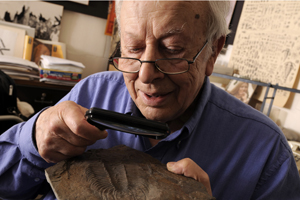Diversion becomes serious quest for new knowledge on extinct marine creatures
By Steve Koppesskoppes@uchicago.edu
News Office
 Photo by Dan Dry Riccardo Levi-Setti, Professor Emeritus in Physics, looks over a specimen of the giant trilobite species he co-discovered with Jan Bergström, professor emeritus at the Swedish Museum of Natural History in Stockholm. Just as Levi-Setti is known in paleontological circles for his trilobite research, he also is known among cell biologists for his work on chromosomes. |
|
Although he is an experimental physicist who discovered new elementary particles in the early ’50s and invented the high-resolution scanning ion microprobe, Riccardo Levi-Setti also is known in paleontological circles for co-discovering a giant trilobite subspecies for his book, Trilobites.
As a diversion, Levi-Setti began decades ago to collect and study these bug-like marine creatures that went extinct 250 million years ago.
A Professor Emeritus in Physics and the College, Levi-Setti unearthed the first specimen of Paradoxides davidis trapezopyge in 1974, while he and his Swedish colleague Jan Bergström were digging for Cambrian trilobites in the Manuels River gorge of eastern Newfoundland.
Bergström, a professor emeritus at the Swedish Museum of Natural History in Stockholm, lauded Levi-Setti as one of a small minority of trilobite collectors who publishes jointly with professional paleontologists.
“Riccardo’s contributions on trilobite vision, in particular, represent a very important addition to our understanding of trilobite function,” Bergström said. “I guess that, in the long run, some intelligent paleontologist would have come up with the same thing, but who knows when—and if?”
Since his early discoveries, Levi-Setti has organized 10 Moroccan expeditions to hunt for trilobites, and he is planning a 2009 expedition to collect more specimens to complete the illustrations of a new trilobite book in the works, this time in color.
He has analyzed trilobite vision on specimens from Bohemia, France, as well as Great Britain, the United States and Morocco. Along with co-author Euan Clarkson of the University of Edinburgh in Scotland, he described the optics of trilobite eyes in 1975.
Writing in the journal Nature, they noted the similarity of certain trilobite lenses with lenses designed in the 17th century by philosopher/scientist René Descartes and physicist/astronomer Christiaan Huygens. The design of these trilobite eyes, Clarkson and Levi-Setti concluded, evolved to increase the concentration of light in their dark oceanic environments.
“These findings show that Darwinian survival of the fittest leads to the optimization of many animal functions, in this case vision, up to the limits imposed by the laws of physics,” Levi-Setti said. “In trilobite vision, this optimization had already been achieved around 450 million years ago.”
The lens-bearing visual surface of the giant trilobites of Newfoundland’s Manuels River gorge has been lost to the fossil record. Nevertheless, the locality ranks among Levi-Setti’s favorite trilobite hunting grounds.
“When I first started digging there, the locality was a gorgeous river gorge with forest all the way down to the river,” Levi-Setti recalled. Further digging revealed that the locality held beautifully preserved, foot-long trilobites.
Unfortunately, the gorge had become a dumping ground for old cars, refrigerators and other refuse. In 1978, Levi-Setti contacted the chairman of the geology department at Memorial University in Newfoundland to recommend that something be done to preserve the locality.
The provincial government obliged. Years later, a cleaned-up Manuels River Linear Park offered miles of scenic nature trails for visitors to enjoy. But the Manuels River Natural Heritage Society banned all digging. Levi-Setti had to curtail his work there.
But last year, that changed when the society asked him for permission to reproduce the trilobite photograph that adorns the cover of his book. Levi-Setti asked if it might be possible for him to resume his work at Manuels River. The society’s governing board then rapidly and unanimously approved his request.
When Levi-Setti resumed his Manuels River excavations during his two-week stay, a Memorial University paleontology student provided assistance, as did members of the society’s governing board.
“It was absolutely wonderful,” said a delighted Levi-Setti. Plans are afoot to build a museum that highlights the scientific importance of the Manuels River, whose fossils are preserved without a trace of the distortions that plague some fossil beds.
“The rocks there have been beautifully preserved horizontally, just the way they were deposited. It’s fantastic,” Levi-Setti said.
One of the most prolific forms of life in the sea during their heyday, trilobites provide valuable evolutionary data. Some trilobite lineages, for example, beautifully illustrate the concept of punctuated equilibria advanced by paleontologists Niles Eldredge and Stephen Jay Gould in evolutionary biology. According to this concept, evolution proceeds in rapid and dramatic steps between long periods of biological stability.
But trilobites are important to Levi-Setti for personal as well as scientific reasons, as he recounts in his book. Having fought with the Italian resistance against the Nazis during World War II, working with trilobites evokes a time before life had conquered land, and humans had yet to invent genocide.
“It is time travel, and, at the same time, an addictive treasure hunt,” Levi-Setti wrote in Trilobites.
![[Chronicle]](/images/sidebar_header_oct06.gif)